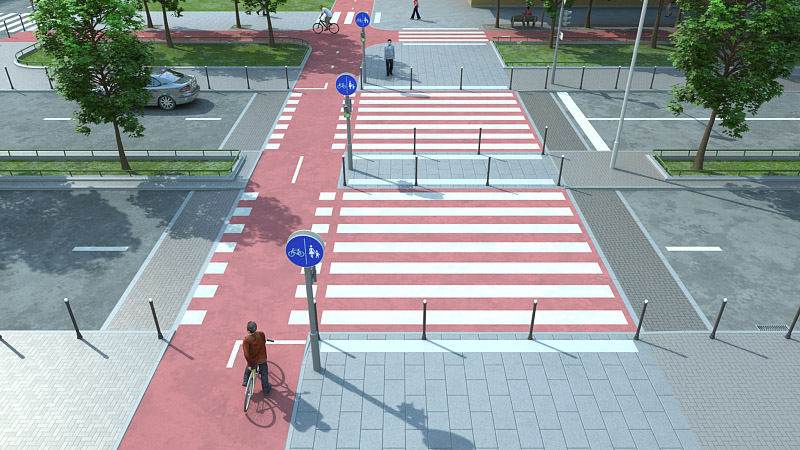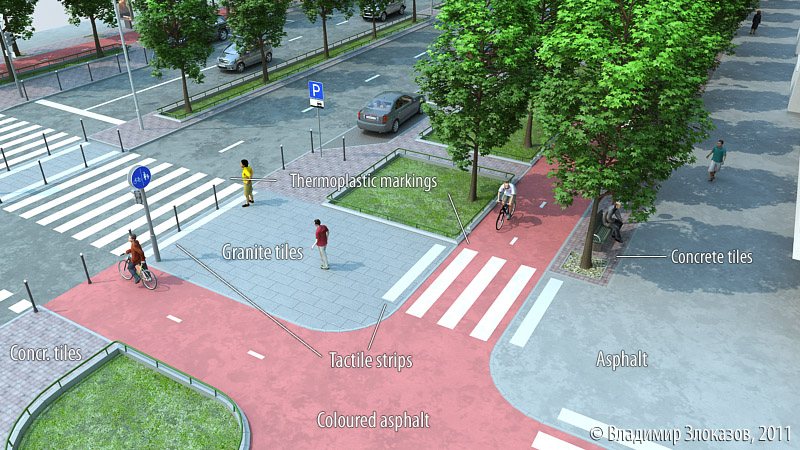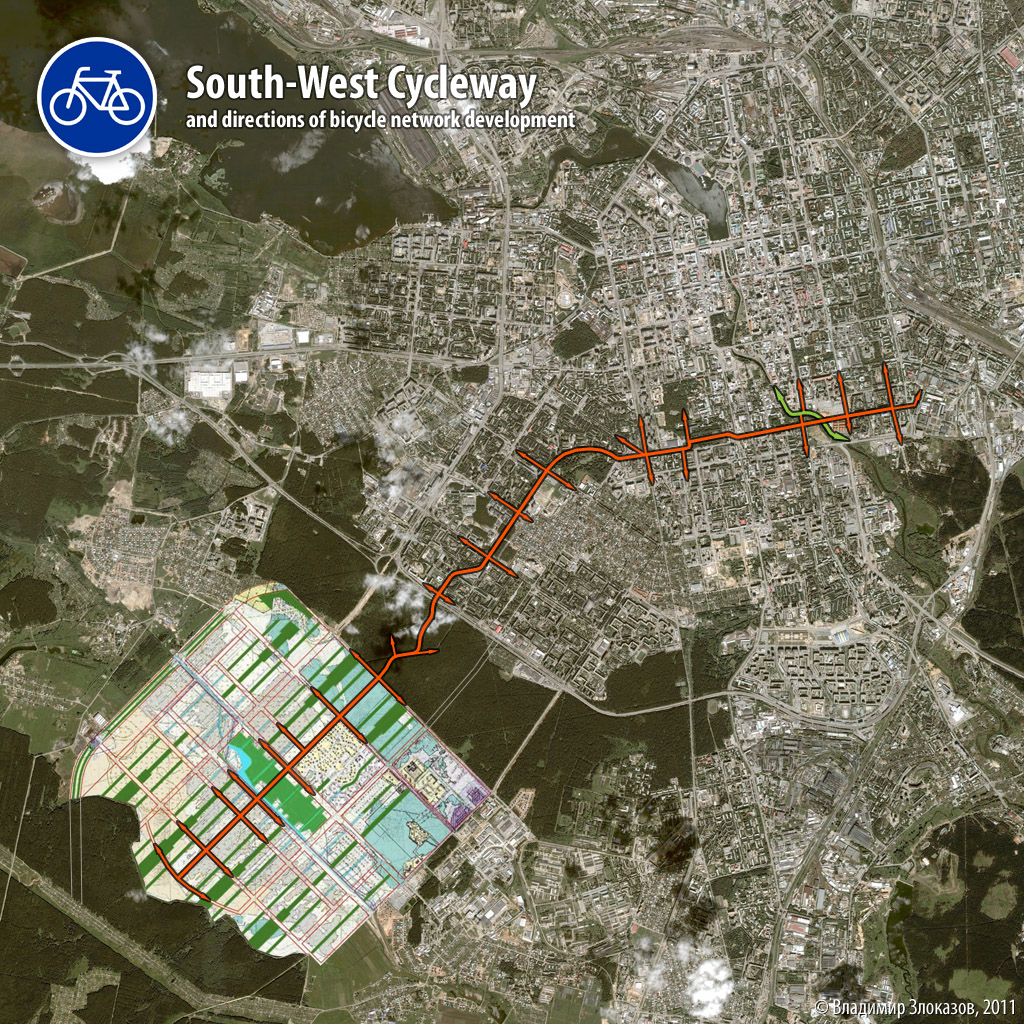Suggestions on project improvement
22.02.2011
Contents
![]()
1. Introduction
2. Overview
3. The drawbacks of the current design and fixing solutions
3.1. Inconvenient pedestrian paths at intersections
3.2. Lack of bicycle paths at intersections
3.3. Excessive turning radii for cars at intersections
3.4. Ineffectual placement of traffic lights
Solution for problems 3.1-3.4
3.5. Lack of parking spaces
Solution for problem 3.5
3.6. Car-oriented driveways
3.7. Lack of low curbs at intersections of bike paths and driveways
Solution for problems 3.6 and 3.7
3.8. Unhuman scale of street lighting
Solution for problem 3.8
3.9. Lack of greenery
Solution for problem 3.9
3.10. Scarcity of pavement types
Solution for problem 3.10
3.11. Lawn strip between the sidewalk and the bicycle path
Solution for problem 3.11
3.12. Lawn protection
Solution for problem 3.12
3.13. Stormwater treatment
Solution for problem 3.13
4. Importance of the street in citywide context
5. Conclusion
![]()
1. Introduction
New Yekaterinburg borough – Academichesky – is promoted by the developer (Renova Stroygroup) as a project that utilizes the most innovative practices in architecture and urban planning. However the first built blocks clearly show that advertisment promises are not always consistent with the reality. Many of designed elements turn out to be outdated and dysfunctional.
This document contains an analysis of the project of Shirokorechenskaya street which was created in OAO UralGiproTrans and planned for realization in 2011 and a series of suggestions on how to make this street more functional for all users.
The original materials of the project are published and are free for downloading on Yekaterinburg City Hall’s official website.
2. Overview
The reviewed segment of the street is situated between Krasnoles’ya street and Sakharova street. On the west it is flanked by Blocks 1 and 2 of Academichesky development and on the east – by Evropeysky Estates development.
The street is composed of a 4-lane carriageway with a median, lawn strips, bidirectional bike paths on each side of the street and sidewalks adojoing the ‘red lines’ of future development.
3. The drawbacks of the current design and fixing solutions
3.1. Inconvenient pedestrian paths at intersections
The first thing to notice while examining the project is the strange arrangement of pedestrian ways at intersections. It seems that the planners tried to move the pedestrian crossings as close as possible to the intersections where they’re ought to be while an overly wide street layout caused the strange and inconvenient configuraton.
 © Uralgiprotrans. Pedestrian space is coloured in beige.
© Uralgiprotrans. Pedestrian space is coloured in beige.
There are streets and intersections in Yekaterinburg with the same problem. Reality proves that in the absense of guard-rails and high fences people behave rationally and prefer direct routes over the curved ones.
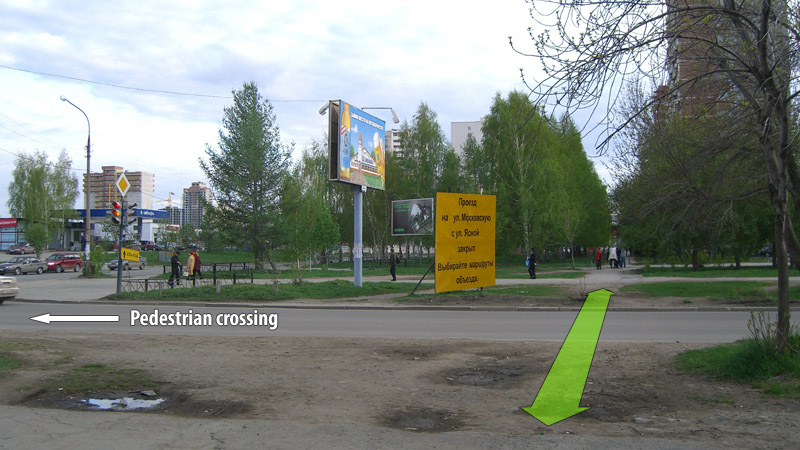 This photo was taken in 2008. Today the direct route is blocked.
This photo was taken in 2008. Today the direct route is blocked.
3.2. Lack of bicycle paths at intersections
Academichesky is the first borough in Yekaterinburg where all the streets will be built with bicycle paths. That is a good thing in general but the quality of these facilities is quite poor. In the reviewed project the bicycle paths run along the streets but abruptly end at intersections. Combined with inconvenient sidewalks configuration that ensures that intersections will be major conflict zones between cyclists and pedestrians.
 © Uralgiprotrans. Bicycle paths are marked with red.
© Uralgiprotrans. Bicycle paths are marked with red.
I won’t try to guess what (according to planners’ opinion) cyclists should do at intersections – to dismount or to continue their way on the sidewalk. I’d only point that the applied method does not comply with any kind of world-class bicycle planning practice which generally consider intersections as priority zones.
 Bicycle markings at intersection in Paris
Bicycle markings at intersection in Paris
3.3. Excessive turning radii for cars at intersections
There is such term as ‘road diet’ in transportation planning practice. It means narrowing the roads and using different means of traffic calming to reduce vehicle speeds and thus improve safety. Basing on that term we can clearly state that what we have in Academichesky is ‘road obese’. The streets are planned for colossal traffic volumes (for residential neighborhood) and the lanes are as wide as 3.75 meters. One of the elements which have a negative impact on street safety is excessive turning radii at intersections which are as big as 8-10 meters.
 © Uralgiprotrans
© Uralgiprotrans
Big turning radii induce drivers to make turns on higher speeds thus increasing the chances of collision with cyclists and pedestrians..
3.4. Ineffectual placement of traffic lights
In several places the project provides traffic lights not at stop-lines but close to intersections. In general such design induces drivers to roll on the pedestrian crossing towards the traffic light thus blocking the passage. That is especially true when road markings are absent which is a usual state of things in Yekaterinburg.
Solution for problems 3.1-3.4
The solution of the above mentioned problems lies in treatment of pedestrian and cycling infrastructure as equally important elements of the street along with the carriageway for cars. The street should not be designed as a space for moving cars with some leftover space reserved for everything else but as a harmonious combination of infrastructure for all users: pedestrians, cyclists and motorists. With that in mind pedestrians and cyclists should have a clear priority embodied in the geometry of the street in cases provided by the street code. The routes for pedestrians and cyclists should be direct and as rational as possible.
In places where pedestrian and bicycle crossings are located afar from the intersections additional measures should be taken to make them clearly visible for motorists. Such as using coloured asphalt for instance.
 Coloured pavement attracts additional attention to the pedestrian/bicycle crossing located afar from the intersection.
Coloured pavement attracts additional attention to the pedestrian/bicycle crossing located afar from the intersection.
The crossing can also be raised above the carriageway to improve visibility and enforce the speed limit:
3.5. Lack of parking spaces
I am not a fan of paving huge amounts of space for the purpose of car parking. Yet if there are no parking places at all and in the absense of proper enforcement drivers will eventually start parking on sidewalks, lawn strips and bike paths. Ths streets in Academichesky represent a rare case in Yekaterinburg when new buildings are not separated from the sidewalk by a parking bay. That is a good thing because shops and offices will be connected directly to the pedestrian ways. But if there are no parking places at all (as it is in the original project) the shop owners will begin cutting ugly ‘parking pockets’ which are most common on our central streets.
Solution for problem 3.5
The most adequate and elegant solution would be creating special parking lanes. Parallel parking being evenly distributed along the street would not dominate the cityscape and would create additional protection for bike paths and pedestrian space. To improve street cleaning and optimize stormwater treatment the parking lane should be raised above the level of the carriageway and can be paved with tiles (thus certain amouts of stormwater would be absorbed on the spot).
3.6. Car-oriented driveways
Intersections of sidewalks with driveways and local roads are traditionally inconvenient and sometimes dangerous for pedestrians. In most cases these intersections are designed as a carriageway dissecting a sidwalk.
 Intersection with local road in the center of Yekaterinburg.
Intersection with local road in the center of Yekaterinburg.
The curbs are rarely lowered properly to allow handicap access. Puddles and dirt often concentrate at such intersections. In winter time they’re cleared from snow worse than sidewalks in genegal due to irregular surface geometry.
 Puddle and dirt where pedestrians have to pass.
Puddle and dirt where pedestrians have to pass.
Moreover the driveway dissecting the pedestrian realm doesn’t enforce the motorists to yield which they must do at these places according to the street code. For that reason motorists often go straight through while pedestrians being scared and feeling obliged by street geometry have to give way.
 Pedestrians looking around cautiously to cross the driveway.
Pedestrians looking around cautiously to cross the driveway.
Is it possible to design the geometry of the street in a way that would stress the priority of pedestrians and cyclists on these intersections?
3.7. Lack of low curbs at intersections of bike paths and driveways
The original project doesn’t presuppose low curbs at places where bicycle paths intersect with driveways.
 © Uralgiprotrans. Red circles mark the problem zones
© Uralgiprotrans. Red circles mark the problem zones
This obvious design mistake have already been implemented on a street nearby:
Solution for problems 3.6 and 3.7
To make driveways and local roads pedestian and bicycle-friendly and these places shoud not be designed as roads dissecting sidewalks and bike paths.
 Traditional configuration. Convenient for motorists and unfriendly to other street users.
Traditional configuration. Convenient for motorists and unfriendly to other street users.
Instead they should be places where cars can cross the continuous sidwalks and bike paths:
 Bike path and sidewalk remain continuous.
Bike path and sidewalk remain continuous.
 Traditional configuration. Convenient for motorists and unfriendly to other street users.
Traditional configuration. Convenient for motorists and unfriendly to other street users.
 Bike path and sidewalk remain continuous.
Bike path and sidewalk remain continuous.
 Avenue Jean Jaures, Paris. Entrance to parking garage doesn’t dissect the sidewalk.
Avenue Jean Jaures, Paris. Entrance to parking garage doesn’t dissect the sidewalk.
 Boulevard Brune, Paris. The sidewalk and the bike path have priority over the driveway.
Boulevard Brune, Paris. The sidewalk and the bike path have priority over the driveway.
3.8. Unhuman scale of street lighting
In Acadmichesky road-type lights are mass used for sidewalk lighting. It is economically viable of course to use one type of street light for everything but a sidewalk flanked with road-type light poles certainly lacks human scale as seen from the photo below.
Moreover the light poles are placed on the either side of the carriageway, taking space from pedestrians and cyclists while purely technical space on the median stays completely unused.
 © Uralgiprotrans
© Uralgiprotrans
Solution for problem 3.8
It is appropriate to divide street lighting into carriageway lighting and sidewalk/bike path lighting. Sidewalk lighting should be more decorative and smaller in scale. Road light poles should be placed in the median where they won’t bother anyone including snow removal machinery in winter. That would also reduce the “light pole forest” effect.
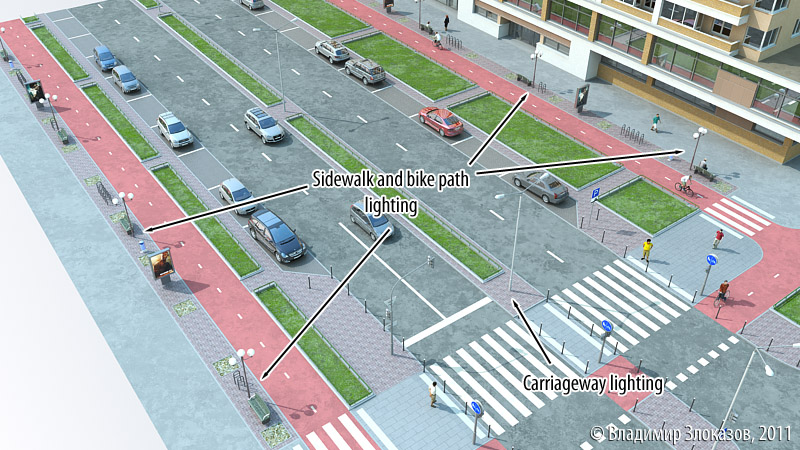 Note: street trees are not shown
Note: street trees are not shown
 Boulevard de Magenta, Paris. Example of separated lighting.
Boulevard de Magenta, Paris. Example of separated lighting.
3.9. Lack of greenery
It is quite clear today that one of major problems of Academichesky will be a lack of greenery. It is due to the specific way of building underground parking under the backyards which does not allow any trees to be planted on the surface. So if the older neighborhoods have shady green backyards used for recreation and play, backyards in Academichesky will remain in the state of concrete jungle, overheated in summer and windy in winter. Parking design can still be reconsidered but if that doesn’t happen the greenery in the streets will be far more important than it is in older neighborhoods.
Today however that issue is not considered at all. For instance on Krasnoles’ya street which was constructed recently there are 8 traffic lanes and not a single row of trees. How nice would it be to have windows overlooking that highway? Or be there on foot or on a bicycle. The reviewed street is 50 meters wide between red lines and only one row of trees is planned for it.
Solution for problem 3.9
The width of the street allows planting not 1 but 5 rows of trees: 2 between bike paths and sidewalks, another 2 between bike paths and carriageway and 1 more in the median. And there would be still lots of space left to lay all the service lines. Trees would divide the funcional zones of the street and create a sort of green ceiling above it smoothing the height of buildings.
The row of trees in the median would visually make the street more narrow thus enforcing the drivers not to speed.
 Additional rows of trees make it look narrower than it really is.
Additional rows of trees make it look narrower than it really is.
3.10. Scarcity of pavement types
Today the pavement types in Academichesky are limited to 2 types: asphalt and concrete tiles also known as “bekhaton”. It seems though that effective functional zoning and aesthetics require a more diverse palette of materials.

Solution for problem 3.10
Main sidewalks. The recent decade was marked with massive usage of small concrete tiles for sidewalk paving. This practice however proved to be a complete failure. Sidewalks paved with concrete tiles are hard to clean both in summer and in winter. They are non-durable and the colour of the tiles lasts only for 1 season. On sidewalks with lots of foot traffic tiles fade in the course of several months. Due to this main sidewalks along buildings on which most of foot traffic will take place should be paved with conventional asphalt. This pavement type is durable, not slippery in winter and easy to clean.
Secondary sidewalks. The above mentioned concrete tiles have however some advantages. One of them is the ability to absorb stormwater (when paved on a layer of sand and stones). Tiles also look good on rarely used foot paths. Thus it is reasonable to use them on technical and secondary sidewalks.
Approaches to intersections and waiting zones. Some places such as pedestrian approaches to intersections can be accentuated with different type of pavement such as unslippery granite.
Bicycle paths. In the context of Yekaterinburg it is reasonable to construct bicycle paths at the same level as sidewalks – to facilitate snow removal. This feature and also the fact that bike paths are new and still uncommon elements of the cityscape require specific attention to them. Putting up signs is not enough.
Today there is a well-developed technology of coloured asphalt production. It would be reasonable to use this asphalt for paving the bicycle paths. This technique is used in the Netherlands for instance.
3.11. Lawn strip between the sidewalk and the bicycle path
In the original project there is a 3-meter wide strip of lawn between the sidewalk and the bike path with some bushes on it.
That is an ineffectual solution for many reasons. If a cyclist wants to stop and wonder into some shop for instance he or she would have to either ride on a sidewalk for some time or break through the bushes. Moreover the bushes separate the bike path from the buildings and the sidewalk thus making it socially unsafe after the sunset.
Is there a better use for the space between the bike path and the sidewalk?
Solution for problem 3.11
Sidewalks should be widened to 4 meters and instead of the lawn strip a functional zone should be created where street trees, light poles, seating, bike racks, litter bins and billboards can be orderly placed. This zone would effectively separate cyclists and pedestrians but will not be impermeable.
 Example of functional zone between a carriageway and a bike path in Paris.
Example of functional zone between a carriageway and a bike path in Paris.
3.12. Lawn protection
There are two types of lawn protection in Yekaterinburg: no protection at all and overprotection (high fences).
Moreover lawns are often very small pieces of land which are very likely to be trampled down.
Solution for problem 3.12
One of the possible ways to make use of lawns and small patches of greenery in dense urban environment is to protect them with low fence and use for more complex greenery than just grass.
 Avenue Jean Jaures, Paris. Low fence prevents walking through a small patch of green covered with various kinds of plants.
Avenue Jean Jaures, Paris. Low fence prevents walking through a small patch of green covered with various kinds of plants.
3.13. Stormwater treatment
Stormwater treatment is an important issue in urban planning and particularly in street design. Conventional approach supposes that water is collected by drains and directed to water treatment plants.
However in case of heavy rains and during snow melting a lot of water goes straight into water basins polluting them with all kinds of chemicals.
Is there a way to reduce the burden on water treatment plants and lessen the impact of urban stormwater runoff on the environment?
Solution for problem 3.13
To our luck the environment and plants in particular can handle certain amount of pollutants and consume stormwater. In the case of the reviewed street we can use patches of lawn as bio swales. For that curbs should have gaps where water would run and the surface of the lawn should be lower than other surfaces of the street.
 © cara rupert on Flickr
© cara rupert on Flickr
4. Importance of the street in citywide context
Shirokorechenskaya street would not be very important for car traffic as it dead-ends on both north and south. But it can become very important for bicycle traffic as a route connecting the new borough with the rest of the city.
5. Conclusion
In a sense streets are more important to the city than buildings. We live and work in buildings but it is in the streets where we meet each other as equals, independently of our social status. This is our public realm. Here we walk, communicated with others, spend time. Streets are the face of the city. They determine the character of the city and the character of life in it.
Construction of the Academichesky borough presupposes construction of many streets from scratch. This offers great opportunities but this is also a serious challenge as these new streets would not have a “historical framwork” on which the planners could rely. Practically it is 100% up to the planners whether the sidewalks would be comfortable and full of people or inconvenient and deserted. Whether the streets would be dominated by cars or by people. Whether bikes path would form a real transportation network or be a fancy note in the brochures. All of it would be determined by the physical form of the street and to achieve good results one should plan the street not as a roadway and some secondary elements but as a public place for people. The street should be treated as a hall or a living room in a building. This exact approach I’ve tried to implement in this review.




